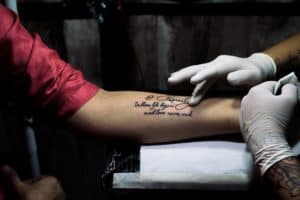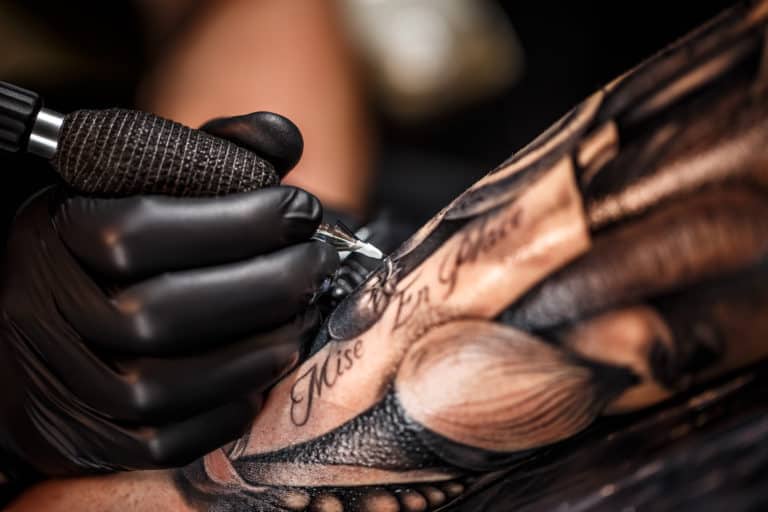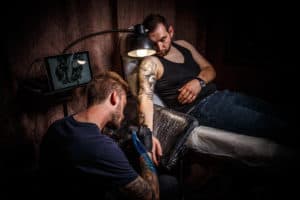In the 1980’s tattoos were still on the fringe of being accepted into mainstream culture. There was a kind of grittiness to it, you had to know somebody that knew somebody, often taking a few weeks to track down a reputable artist going by a nickname.
Because of such, even today there are many questions about tattoos that the everyday person might have, with answers not widely available to them, such as how does a tattoo heal?
What is the healing process of a tattoo?
With the skin being a living canvas, there are several steps along the way after a tattoo is finished being laid down that can cause anxiety for a person unfamiliar with it. The skin is the largest organ of the body, known as the integumentary system, and it heals in several steps.
A tattoo machine causes trauma to the skin, via the rapid insertion of the needles into the skin. This trauma is similar to a light scratch although it is over a large surface area. The healing is very similar to a light scratch, just more pronounced due to the size of it.
The Steps of Healing
First of all, the skin isn’t as simple of most would be led to believe. It is a system of the body known as the integumentary system. There are several layers to it, three in fact, known as the epidermis, the dermis, and the hypodermis.
Each one of these layers of the skin hold different and important functions relating to the health of the body and to the skin itself.
- The epidermis is the outermost layer, or rather the surface layer. The purpose of the epidermis is to create a waterproof barrier for the body from the outside world. This helps to keep bacteria out of the body and water in.
- The dermis, the middle layer, is where many of the glands of the skin are, such as the sebaceous glands that produce oil, sweat glands, hair follicles, and connective tissue.
- Then there is the hypodermis which is largely comprised of fat and connective tissue. This helps keep the body warm. Fun fact here, is that humans are the only primate descendant that stores fat in our bodies under the skin, similar to sea mammals. Other primates have fat around their organs in a more interior fashion.
When the skin is damaged several functions of the integumentary system are activated. Since the first function of the epidermis is to keep bacteria out and damage to the skin impedes this ability,
even though the tattooing process causes the minimal damage to the epidermis, it can still cause bleeding. The first stages of wound repair are known as hemostasis and inflammation.
Hemostasis is the process through which the body attempts to keep blood in the body, through the process of clotting. So, like with any other wound that causes bleeding, the blood will turn from a liquid to a gel through the use of platelets, a component of the blood, and other clotting agents.
After and during hemostasis, because the body is a very very efficient machine, inflammation will occur. Inflammation is also a stage of healing, where the site of injury is flooded with white blood cells. This is to remove cellular debris and any invading pathogens from the area. This occurs through phagocytosis, where the white blood cells will literally eat debris and pathogens. Removing them from the site of injury and deny pathogens the ability to propagate.
Once hemostasis and inflammation have occurred, bringing the bleeding and pathogenic threats under control, the skin will begin to heal itself. Healing of the skin and replacement of damaged tissue is also complex and has multiple stages.
Another important thing to note, when it comes to how a tattoo heals, is that the healing process involves the creation of new skin cells that are created by stem cells in the dermis that migrate to the site of injury. A more thorough explanation of the healing process is not necessary for explaining how a tattoo heals and would just be way too much information.
What to Expect During Healing
During the Session
One of the first things a person may notice while getting a tattoo is that not very long after the first line has been laid down, swelling will begin to occur. This is an example of just how quickly the body reacts to damage. This is hemostasis and inflammation in effect.
The neat thing to note is the line work will be raised and generally no weeping of blood or other body fluids will occur. At least not at first, after a while though the pressure of inflammation will cause blood and plasma to seep through the damaged skin. This is perfectly normal.
After the Session
Around an hour or two after the tattoo is finished, also depending on how long the tattoo took to complete, the entire site will most likely be seeping plasma and blood for several hours. I’ve personally had a tattoo take around 24 hours to completely stop bleeding. Again, this is perfectly normal and often the swelling will subside before the site stops seeping.
The commonly accepted best practice of tattoo aftercare is as follows:
- After the tattoo is completed, the artist should clean the site using a dilution of soap and water.
- After cleaning, the site should be covered in some type of wound dressing in order to restrict access to the wound site from contact with pathogens, airborne or otherwise. This can vary from one artist to the next depending on how they learned the trade and are most comfortable with.
- Keep this bandage on for 24 hours. During this period hemostasis and inflammation will significant. So, the fluid build-up on the skin is a potential disease vector for pathogens.
- At some point towards the end of the 24-hour period, the plasma and blood should gel up and harden, clotting if you will. This is a temporary fix to maintain the integrity of the epidermis while it is healing. It is now at the safest point to remove the dressing.
- After removing the dressing, it is time for what is called hydrotherapy. Gently wash the site with non-scented antimicrobial soap and water, no scrubbing, and pat the site dry. Scrubbing with only agitate the healing process and may even start the inflammation and hemostatic processes up again.
- Do not redress the wound, the skin has a need to breath in order to effectively heal. Instead apply an antimicrobial ointment to it a few times a day and use a non-scented moisturizer in order to keep the skin moist. My favorite moisturizer to use is called Hustle Butter (Amazon Link).
- Repeat this last step for the course of about two to three weeks, depending on the size of the tattoo and how your body heals.
We’ve just covered the immediate aftercare instructions. However, there are a few other things to note:
Other Tips on the Healing Process
Tattoo aftercare is not a congruent topic across the United States, which each state having its own laws and regulations regarding the trade. So here are some other less discussed tips to be aware of during tattoo healing.
- Avoid direct sunlight to the tattoo, ultraviolet light is the worst enemy of tattoo ink. Once your tattoo is fully healed, you should make sure to apply sunscreen made for tattoos to protect it from fading. The sunscreen I use the most is called CannaSmack (Amazon Link).
- Avoid hot showers and swimming.
- Avoid tight fitted clothing.
- Avoid picking at any scabs, this can cause ink to bleed out an make a potential infection site.
All of the above can damage the tattoo and cause the ink to fade. Tight fitted clothing can stick to the site and interrupt the healing process. In fact, in the case of sticky clothes, do not pull the clothes off but wet the area and let it sit for a minute. Hopefully this will either cause the clothes to unstick from the tattoo or make it much easier to remove.
If clothing fibers or pet hair do get stuck, simply clean gently with antimicrobial soap and water.
Remember earlier when I used to term Best Practice? This also includes the antimicrobial ointments and soaps you use in the care of the tattoo during the healing process. These ointment and soaps can vary from one shop to the next and one opinion to the other. The tattooing industry is a highly opinionated field.
Be sure to use Medical Grade ointments and soaps. Non-scented and hypoallergenic.
What to Expect During Healing
Besides the actual healing processes occurring in the body there are a few other healing factors to be aware of that may cause a first-time tattoo recipient some anxiety. Some of this I have already covered, such as wound seeping and scabbing.
Remember that the scabbing is a natural part of the healing process and needed for proper healing of the skin and the tattoo itself. As tempting as it may be to peel a scab off, it can cause a scar in the skin and tattoo and cause possible infection.

In fact, I knew this one tattooist who managed to take such good care of her most recent tattoo the skin that peeled came off in one whole piece, like an invisible bandage. Weird, but it happens and perfectly normal. Everyone’s body is a little different.
Redness at the site of the tattoo is perfectly normal as well. The redness is caused by the site of a wound being flushed with blood filled with essential nutrients and oxygen to accelerate the healing factor. The redness should dissipate after a few days.
Soreness is also kind of a no-brainer associated with tattoos. It should feel like a sunburn or light bruise and this feeling should also dissipate after a week or so as the healing process gets into full swing.
Colors in a tattoo will often appear very bright for the first day or so and then fade, sometimes quite dramatically. No worries here either, remember that the skin is flushed with plasma, white blood cells, blood, and new cells. Even though it is a relatively thin layer, the pigments of color will seem duller at first simply due to the natural refraction of light reaching them.
Wondering why your new tattoo isn’t peeling? Check out my article here that I wrote specifically on this topic.
As the tattoo heals these colors will return to their brightness they had on the first day. Which brings us to the last point.
Something referred to as a “Silver Sheen” may appear on the tattoo during the final healing stages. This may last up to several weeks, maybe even 6 or more. This sheen are the new cells that have replaced the damaged cells of the epidermis. This sheen will eventually fade, and you will be left with your completely healed tattoo, looking as fresh as a daisy.
What to Look Out for During Healing
Now look, just because you followed all the steps for healing does not mean that there may not be complications during the healing process. Even people who hold a medical doctorate and many years of experience may have patients that develop complications.
The purpose of study and experience is to reduce the amount of risk involved with procedure and give accurate advice, no one is perfect.
There are several complications that can occur during and after a tattoo that may need medical attention. This is not to raise alarm that tattooing is unsafe, especially if you get a tattoo in a shop.
Shop artists depend on being capable of not only good art but being capable of reducing risk through education of tattoos and creating a hygienic environment for their clients. Their reputation and lifestyle depend on it.
Allergic Reactions
Tattoo ink is not regulated by the FDA, most tattoo artists may use a variety of inks from different suppliers. The pigments in these inks used to achieve proper color and saturation may vary from one brand to the next, and often these ingredients are trade secrets.
If you happen to have a tattoo the is swollen beyond the norm for a much longer period than is normal, being 24-48 hours, then you may be having an allergic reaction to one or more of the inks used.

While I have never heard of this happening personally, it might cause anaphylactic shock, so if you at any point in time have difficulty swallowing or breathing you should seek immediate medical attention.
If you have an allergic reaction to an ink, you should ask your tattoo artist what inks they are using and avoid those inks or colors in the future.
Infections
Infections are generally quite rare, especially if you are getting a tattoo at a reputable shop. But keep in mind that staph lives on the skin and tattoo aftercare is just as important to decrease the risk of infection. Realize I said decrease the risk, the world is constantly competing on all levels for food, you are food too.
Where you go after getting a tattoo plays a role in this. If you stay at a hotel or go to a hospital after a tattoo you are running the high risk of catching an infection. These places are filled with pathogens of all types.
So, if your tattoo starts to turn green or slimy, or otherwise look infected, then you probably have an infection. Which can utterly ruin a tattoo. Also, something to seek immediate medical attention for.
Despite all these factors involved in the healing process, complications are quite rare, so go out there and have some fun. Dare to pay for an embarrassing tattoo when your friend loses the next bet.


